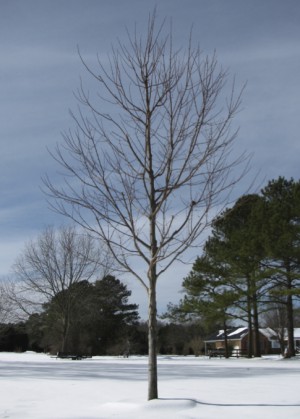Training young trees for proper structure and form is essential for the continued health, beauty and long-life of our landscape trees. Many tree structural failures can be traced back to improper care of young trees. Training young trees, or formative pruning, can reduce and eliminate many structural defects, decreasing future storm damage, and improving the quality of our urban forest.
What’s the Problem?
The majority of young shade trees in Hampton Roads are pruned improperly or never pruned at all. This leads to unnecessary structural defects, the primary culprit for broken branches and split trees after a wind storm. It helps to remember that our urban landscape is an alien environment for most of our native trees. Many of our native trees are adapted to grow vigorously towards a narrow column of sunlight. Why?
Our native eastern deciduous forest creates a continuous canopy, and only occasionally, perhaps upon the death of a dominant oak or tuliptree, will a column of light reach the forest floor. After a sudden opening in the forest canopy, many native trees send a single dominant leader shooting towards the sunlight. Contrast this image with a typical urban landscape, where bright sunlight may reach a young tree during all daylight hours. Being exposed to sunlight in every direction, many young urban trees will grow multiple leaders in multiple directions. As the tree matures this often leads to codominant stems and other structural defects.
Unfortunately, another common problem is the pruning technique used at some tree nurseries. Many planted trees have had their terminal leader removed at the nursery to encourage branching, perhaps to grow a more “marketable looking” tree.
Training Young Trees for Good Structure

Young red maple with a strong central leader
Understanding the growth habits of each species being pruned is essential when training young trees. Our ISA Certified Arborists are formally trained to use a five-step technique:
- Remove broken, diseased, dying, or dead branches.
- Select a dominant leader, remove competing leaders.
- Select the lowest permanent branch.
- Select scaffold branches, remove competing branches.
- Select temporary branches and shorten them.
Using this technique, we can train most species of young trees to develop well-spaced, strongly attached branches, a well-tapered trunk, and a dominant central leader. Less pruning will be needed as the tree matures and costs associated with the correction of structural defects, such as cabling, bracing and heavy pruning can be avoided. Properly pruned trees will be stronger and significantly less susceptible to storm damage. They will retain the beauty and symmetry that we desire from our landscape trees. The investment is minimal and it is clear that if we want beautiful and healthy trees, we should train young trees.
In Hampton Roads, training young trees using formative pruning techniques is best performed on most species in January and February. When leaves are absent we can see the overall structure of the tree. If you want to improve the structure of your trees and eliminate future problems, call or email us and we’ll set up an appointment.
